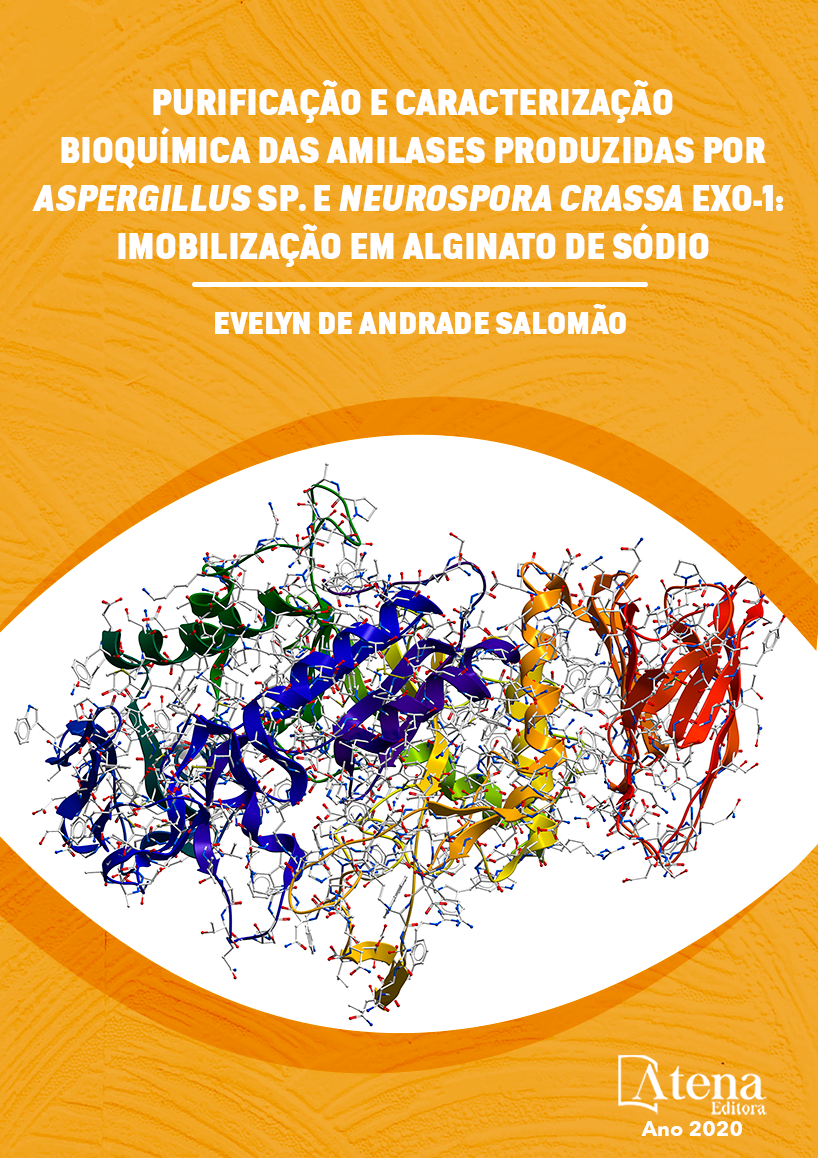
PURIFICAÇÃO E CARACTERIZAÇÃO BIOQUÍMICA DAS AMILASES PRODUZIDAS POR Aspergillus sp. E Neurospora crassa EXO-1: IMOBILIZAÇÃO EM ALGINATO DE SÓDIO.
O complexo enzimático amilolítico é de grande importância industrial, dentre os fungos filamentosos capazes de produzir essas enzimas estão os do gênero Aspergillus, considerados excelentes produtores e o Neurospora crassa Mutante exo-1, hiperexpressor da glucoamilase. Esse estudo teve por objetivo purificar, imobilizar e caracterizar amilases produzidas por esses fungos. A α-amilase produzida pelo Aspergillus sp. apresentou purificação de 7,59x e 82,79% de rendimento. A imobilização foi realizada em alginato 3,5% e cloreto de cálcio 0,5M apresentando aproximadamente 40% de atividade até o quinto ciclo de reuso. Os valores de pH e temperatura ótimos, para as enzimas livre e imobilizada, foram 4,5 e 65°C e 4,5 e 60°C, respectivamente. Os testes de estabilidade ao pH da enzima imobilizada mantiveram valores próximos a 100%, enquanto que a livre apresentou queda de 50% da atividade em todas faixas de pH. Na estabilidade à temperatura a enzima imobilizada manteve 100% de atividade em 40°C. A enzima livre apresentou 100% de atividade em 40 e 55°C. A glucoamilase produzida pelo Neurospora crassa Mutante exo-1 apresentou purificação de 1,75x com 31,27% de rendimento. Para a imobilização foram utilizados alginato 4% e cloreto de cálcio 0,1M, mantendo 35% da atividade no sexto ciclo. Os valores de pH e temperaturas ótimos obtidos para a enzima livre e imobilizada foram de pH5,0 e 65°C e pH5,5 e 55°C, respectivamente. Na estabilidade ao pH a enzima livre apresentou estabilidade em pH4,0-8,0, já a enzima imobilizada reteve menos de 20% da atividade em todos os pH. A enzima livre reteve aproximadamente 100% de sua atividade a 40 e 45°C, enquanto que a imobilizada reteve menos de 15% da atividade em todas as temperaturas no teste de estabilidade à temperatura. A imobilização enzimática em alginato pode ser promissora por ser de fácil processamento e pela possibilidade de recuperação e reutilização da enzima.
PURIFICAÇÃO E CARACTERIZAÇÃO BIOQUÍMICA DAS AMILASES PRODUZIDAS POR Aspergillus sp. E Neurospora crassa EXO-1: IMOBILIZAÇÃO EM ALGINATO DE SÓDIO.
-
DOI: 10.22533/at.ed.049202304
-
Palavras-chave: amilase, fungos filamentosos, imobilização enzimática
-
Keywords: amylase, filamentous fungi, enzymatic immobilization
-
Abstract:
The amylolytic enzyme complex has a great industrial importance, among the filamentous fungi capable of producing these enzymes are those of the genus Aspergillus, considered excellent producers and the Neurospora crassa Mutant exo-1, glucoamylase hyperexpressor. This study aimed to purify, immobilize and characterize amylases produced by these fungi. The α-amylase produced by Aspergillus sp. obtained purification of 7.59 fold and 82,79% yield. The immobilization was carried out in alginate 3.5% and calcium chloride 0.5M presenting approximately 40% activity up to fifth reuse cycle. The optimum pH and temperature values, for free and immobilized enzymes, were 4.5 and 65°C and 4.5 and 60°C, respectively. The pH stability tests of the immobilized enzyme remained close to 100% while the free form showed 50% decrease in activity in all pH ranges. In the temperature stability the immobilized enzyme maintained 100% activity at 40°C. The free enzyme showed 100% activity at 40 and 55°C. Glucoamylase produced by Neurospora crassa Mutant exo-1 showed a purification of 1.75 fold and 31.27% yield. For the immobilization were used 4% of alginate and 0.1M calcium chloride, maintaining 35% of the activity in sixth cycle. The optimum pH and temperatures values obtained for the free and immobilized enzymes were pH5.0 and 65°C and pH5.5 and 55°C, respectively. In pH stability test the free enzyme demonstrated great stability at pH4.0-8.0, the immobilized enzyme retained less than 20% of activity at all pH. The free enzyme retaining approximately 100% of its activity at 40 and 45°C, while immobilized retained less them 15% of activity at all temperatures in temperature stability test. Enzymatic immobilization in alginate can be promising because it is easy to process and possibility of recovery and reuse of the enzyme.
-
Número de páginas: 63
- Evelyn de Andrade Salomão


